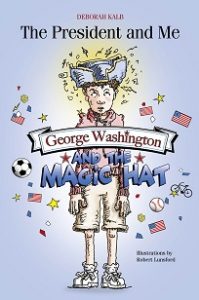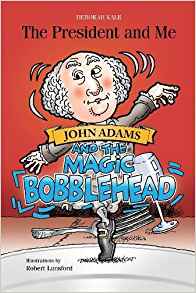Humor and History
 If you’re trying to write somewhat humorous fiction for kids about historical characters, it helps if the historical characters are quirky. So, keeping that principle in mind, it was easier to wring some humor out of John Adams than it was with George Washington.
If you’re trying to write somewhat humorous fiction for kids about historical characters, it helps if the historical characters are quirky. So, keeping that principle in mind, it was easier to wring some humor out of John Adams than it was with George Washington.
I’m writing a series of middle grade novels that feature regular modern-day kids from Bethesda, Maryland, who travel back in time and meet the early presidents. I started writing the first one, George Washington and the Magic Hat, a few years ago, and it was published in 2016. As my protagonist, absent-minded fifth-grader Sam, muses in one of his internal monologues, “George Washington did seem like an amazing guy. Almost too amazing. Too perfect. Had he ever done anything wrong in his life?…Did George ever think things were funny, or was he totally serious all the time?”
Okay, so what do you do with that? I decided, for the sake of my story, that George would be amused, avuncular, able to see the humor in some of the things around him. Such as when he encounters a modern-day George Washington figure, namely George the Racing President, the Washington Nationals mascot, who ends up traveling back to the 18th century with Sam. Or when Sam’s neighbor J.P. shows him a Star Wars Lego, which George finds most fascinating. But quirky? No.
Thankfully, when I was writing the second book in the series, about the second president, John Adams, I had more to work with. (John Adams and the Magic Bobblehead is scheduled to be published this November.) Adams was hot-tempered, garrulous, and sharp-tongued, but he displayed a sense of humor and self-awareness in his writing. In 1822, almost a half-century after the signing of the Declaration of Independence, Adams recalled why Thomas Jefferson—who, along with Adams, was a member of a five-person committee charged with drafting the Declaration—was chosen to write it.
 “Reason 1st.,” he remembered telling Jefferson. “You are a Virginian, and Virginia ought to appear at the head of this business. Reason 2d. I am obnoxious, suspected and unpopular; You are very much otherwise. Reason 3d: You can write ten times better than I can.” So Jefferson agreed.
“Reason 1st.,” he remembered telling Jefferson. “You are a Virginian, and Virginia ought to appear at the head of this business. Reason 2d. I am obnoxious, suspected and unpopular; You are very much otherwise. Reason 3d: You can write ten times better than I can.” So Jefferson agreed.
Abigail, John Adams’s wife, also had a strong personality. She clearly didn’t suffer fools gladly. An early feminist, she spoke up about political issues, famously urging her husband in 1776 to “remember the ladies” when crafting the future country’s laws. The letters back and forth between John and Abigail over many years, when Abigail was home in Massachusetts managing the household and the children, and John was serving in various government posts from Philadelphia to Paris, provide a treasure trove of personal information.
Unfortunately, very few letters between George and Martha Washington still exist. Martha, perhaps seeking privacy, destroyed their correspondence after George died in 1799. I did include Martha in the first book, but only briefly. Abigail, however, is a major character in the second book.
The other night, I had the privilege of seeing the incredible musical Hamilton. Fittingly, George Washington is portrayed as a formidable military man, an illustrious political leader, and a wise, understanding surrogate father to Alexander Hamilton. John Adams, meanwhile, is mocked as a figure of fun who will never succeed as president. (Thomas Jefferson, whom I’m writing about now, is painted as a scheming villain—but one with principles.)
While the 21st century kids in my books travel back in time to meet George Washington using a tricornered hat my character Sam buys at the Mount Vernon gift shop—it turns out to talk, and to possess magical abilities—the kids in the second book go back and forth to the Revolutionary period using an irascible, talkative John Adams bobblehead that they purchase at the John Adams Visitor Center in Quincy, Massachusetts. Yes, George Washington bobbleheads do exist, but somehow the idea of a magical, talking George Washington bobblehead wasn’t as funny.
 In John Adams and the Magic Bobblehead, John and Abigail are incensed when two of the modern-day kids, unable to deal with the idea of time travel, keep insisting that the Adamses are not real. The John Adams bobblehead, for his part, gets upset when the same two kids refuse to believe that the bobblehead is capable of eating. (The modern-day action in this book takes place at a family wedding in Boston, and features a lot of scenes involving food. The bobblehead marvels over the changes that have befallen its alma mater, Harvard University, since the 18th century. And it develops a taste for contemporary music, pirouetting around the table at the wedding and knocking over a glass of water. Can you imagine George doing that?
In John Adams and the Magic Bobblehead, John and Abigail are incensed when two of the modern-day kids, unable to deal with the idea of time travel, keep insisting that the Adamses are not real. The John Adams bobblehead, for his part, gets upset when the same two kids refuse to believe that the bobblehead is capable of eating. (The modern-day action in this book takes place at a family wedding in Boston, and features a lot of scenes involving food. The bobblehead marvels over the changes that have befallen its alma mater, Harvard University, since the 18th century. And it develops a taste for contemporary music, pirouetting around the table at the wedding and knocking over a glass of water. Can you imagine George doing that?
In any case, both books were a delight to write. I hope people enjoy reading them as much as I enjoyed writing them. And for the Thomas Jefferson book, I’m going back to the magic hat.
Thanks so much!
—
Deborah Kalb is the author of the middle grade novel George Washington and the Magic Hat, and its forthcoming sequel, John Adams and the Magic Bobblehead. She worked in journalism for two decades, based in Washington, D.C.
Find out more about her on her website http://deborahkalbbooks.blogspot.com/
Category: On Writing
























